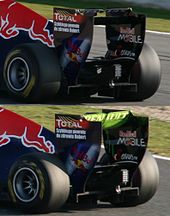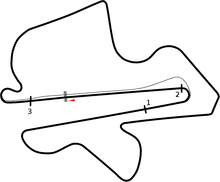
In motor racing, the drag reduction system (DRS) is a form of driver-adjustable bodywork aimed at reducing aerodynamic drag in order to increase top speed and promote overtaking. It is an adjustable rear wing of the car, which moves in response to driver commands. DRS often comes with conditions, such as the requirement in Formula 1 that the pursuing car must be within one second (when both cars cross the detection point) for DRS to be activated.
DRS was introduced in Formula One in 2011 and is planned to used until the 2025 season. The use of DRS is an exception to the rule banning any moving parts whose primary purpose is to affect the aerodynamics of the car. The system is also used in the Formula Renault 3.5 from 2012 until it folded in 2017, Deutsche Tourenwagen Masters since 2013, Super Formula since 2014, GP2 Series later FIA Formula 2 Championship since 2015, GP3 Series later FIA Formula 3 Championship since 2017. An adjustable wing was also used by the Nissan DeltaWing at the 2012 24 Hours of Le Mans, although with free usage.
DRS is set to be removed in Formula One for the 2026 season, as it will be replaced with an "active aerodynamics" system under the new 2026 regulations.
Rationale
In most higher-performance racing categories, the cars depend on the downforce produced by their aerodynamic bodywork to increase cornering speeds. However, the aerodynamic bodywork, particularly wings, has the side effect of producing turbulence in the region behind the vehicle. The following car's front wing will work less effectively in the turbulent airflow, meaning that the following car's cornering performance is compromised.
By contrast, in circuit racing categories where downforce is less of a factor (for example, NASCAR), the following car has an aerodynamic advantage, because of the aerodynamic drag reduction from drafting and little or no effect on cornering performance.
The net effect is to make overtaking much more difficult, and thus infrequent, in categories with high levels of downforce , making the sport less interesting to spectators.
Formula One
In Formula One, the DRS opens an adjustable flap on the rear wing of the car, in order to reduce drag, thus giving a pursuing car an overtaking advantage over the car in front. The FIA estimate the speed increase to be between 10–12 km/h (6.2–7.5 mph) by the end of the activation zone, while others, such as technical staff at racecar-engineering.com, cite a much lower figure of 4–5 km/h (2.5–3.1 mph). When the DRS is deactivated or closed, it increases downforce, giving better cornering.
Between 2011 and 2023, the device could only be used during a race after two racing laps had been completed, and when the pursuing car entered a designated "activation" zone defined by the FIA. This also included having to wait 2 laps after a safety car restart. In 2024 the rule was changed and now the device can be used during a race after only one racing lap after the race start or a safety car restart has been completed.
In 2011, the FIA increased the number of DRS zones to two on some circuits featuring multiple long straights. In Valencia and in Montreal, two zones were endorsed on consecutive long straights, while in Monza and in Buddh, two zones were created on separate parts of the circuit. Two zones had originally been planned for every race with multiple long straights from Montreal onwards (depending on Montreal/Valencia success), but this was not implemented. However, at the penultimate round of the 2011 season, two zones on consecutive long straights saw a return at Yas Marina.
When usage of the DRS remained legal for the 2012 season, a second zone was added to the opening round's track in Melbourne. A third DRS zone was added during 2018 and 2019 seasons in Australia, Bahrain, Canada, Austria, Singapore, and Mexico. In the 2022 season, a fourth zone was initially added for the track in Melbourne, after the circuit redevelopment, before being removed for safety reasons. In the 2023 season the zone was re-added. Bahrain, Jeddah, Melbourne, Baku and Miami had their DRS zones adjusted based on whether the FIA deemed DRS made overtaking at these five circuits too easy or too hard in 2022. A fourth DRS zone was added in Singapore in 2024.
DRS is set to be made obsolete in the 2026 season, being replaced with an "active aerodynamics" system.
Functional description
The horizontal elements of the rear wing consist of the main plane and the flap. The DRS allows the flap to lift a maximum of 85 millimetres (3.3 in) from the fixed main plane. This reduces drag from the wing and results in less downforce. In a straight line, where downforce isn't needed, it allows for faster acceleration and potential top speed, unless limited by the mechanical limits of the engine and transmission. Sam Michael, sporting director of the McLaren team, believes that DRS in qualifying will be worth about half a second per lap.
The effectiveness of the DRS will vary from track to track and, to a lesser extent, from car to car. The system's effectiveness was reviewed in 2011 to see if overtaking could be made easier, but not to the extent that driver skill is sidelined. The effectiveness of DRS seems likely to be determined by the level of downforce at a given circuit (where the cars are in low drag trim at circuits like Monza, the effects may be smaller), length of the activation zone, and characteristics of the track immediately after the DRS zone.
Rules on use

Use of DRS is restricted by the F1 rules; it is permitted only when both:
- The following car is within one second of the car to be overtaken, which may be a car being lapped. The FIA may alter this parameter, race by race.
- The following car is in an overtaking zone as defined by the FIA before the race (commonly known as the DRS zone).
Further:
- The system may not be activated until the end of one lap (from 2024) after the race start, restart, or a safety car deployment, for example, as was the case of the 2021 Belgian Grand Prix, during which no driver could have activated DRS because the entire race took place behind a safety car, before being terminated due to bad weather.
- The system cannot be used by the defending driver, unless within one second of another car in front.
- The system may not be enabled if racing conditions are deemed dangerous by the race director, such as rain, as was the case at the 2011 Canadian Grand Prix.
A dashboard light notifies the driver when the system is enabled (the driver can also see the system deploy in his wing mirrors). The system is deactivated when the driver releases the button or uses the brakes.
There are lines on the track to show the area where the one-second proximity is being detected (the detection point) and a line later on the track (the activation point), along with a sign vertically marked "DRS" where the DRS zone itself begins.
Reception
There has been a mixed reaction to the introduction of DRS in Formula One amongst both fans and drivers. Some believe that this is the solution to the lack of overtaking in F1 in recent years while others believe this has made overtaking too easy. Former Formula One and Team Penske IndyCar Series driver Juan Pablo Montoya described it as "like giving Picasso Photoshop". The principal argument for the opponents of DRS is that the driver in front does not have an equal chance of defending his position because they are not allowed to deploy DRS to defend. The tightening up on the rules for a leading driver defending their position has added to this controversy. In 2018, then-Scuderia Ferrari driver Sebastian Vettel stated that he preferred throwing bananas Mario Kart-style over the use of DRS, arguing that it's "artificial".
Road car use
The McLaren P1 coupé is the first road car to have incorporated the F1-style rear wing Drag Reduction Systems. McLaren Senna GTR and Porsche 911 (992) GT3 RS later followed suit by the introduction of the same system in 2019 and 2022 respectively.
See also
References
- "2011 F1 Technical Regulations, Section 3.18" (PDF). argent.fia.com. 8 March 2011. Retrieved 8 May 2024.
- New Formula Renault 3.5 racer unveiled at Silverstone – Autoblog, 24 August 2011
- DTM's DRS system will be limited at Brands Hatch – Mattias Ekstrom – Autosport, 14 May 2013
- ^ Noble, Jonathan (6 June 2024). "How F1's new active aero will work in 2026". Autosport.
- "Feature: Downforce in Formula One, Explained". Mercedes-AMG PETRONAS F1 Team. Retrieved 11 December 2024.
- ^ "TECH TUESDAY: How the rear wing of the 2022 car has been designed to be an F1 gamechanger | Formula 1®". Formula 1® - The Official F1® Website. Retrieved 11 December 2024.
- "How NASCAR Drafting Works". HowStuffWorks. 5 December 2008. Retrieved 11 December 2024.
- "What is Formula 1 DRS?". F1 Chronicle. 25 November 2020. Retrieved 23 August 2021.
- Sam Collins (30 March 2011). "DRS: The Drag Reduction System explained". Racecar Engineering. Chelsea Magazine Company, part of the Telegraph Media Group. Retrieved 5 October 2023.
- "New F1 sprint format + DRS and engine limit tweaks announced". The Race. 5 February 2024. Retrieved 5 February 2024.
- "Two race DRS zones from Montreal onwards". Adam Cooper's F1 Blog. 20 May 2011.
- Luke Smith (21 May 2018).*Third DRS zone added for F1 Australian GP at Albert Park". Crash.net.
- "FIA removes one F1 DRS zone at Albert Park on safety grounds". Motorsport. 9 April 2022. Retrieved 9 April 2022.
- "Melbourne ci riprova: "Quattro zone DRS"". Formulapassion.it (in Italian). 20 February 2023. Retrieved 20 February 2023.
- "2023 FIA Formula One World Championship Formula 1 Commission meeting 21.02.23". Fédération Internationale de l'Automobile. 21 February 2023. Retrieved 21 February 2023.
- "A new fourth DRS zone in Singapore". Pirelli.com. 17 September 2024. Retrieved 17 September 2024.
- "BBC Sport - Is DRS making overtaking too easy?". BBC Sport.
- Juan Pablo Montoya reckons DRS has made Formula 1 less challenging – Autosport, 26 April 2014
- "F1 2011 Sporting Regulations"
- Vettel: ‘throwing bananas’ from cockpit ‘more fun’ than DRS
- Lloyd, Harrison (8 August 2023). "DRS In Formula 1: How, Why, And When Is It Used?". Formula Driven. Retrieved 8 August 2023.
- "Officially Official: the new McLaren P1". 27 September 2012.
- "Downforce Update".